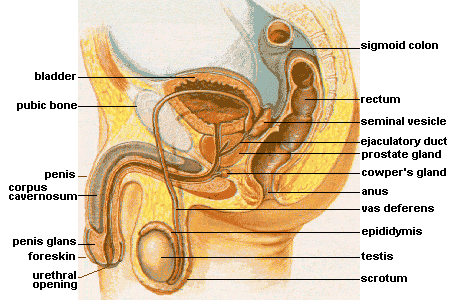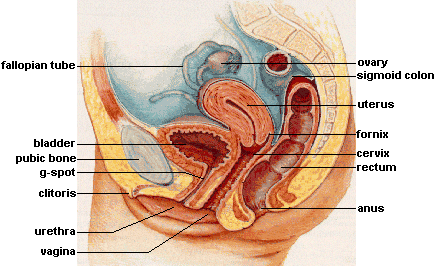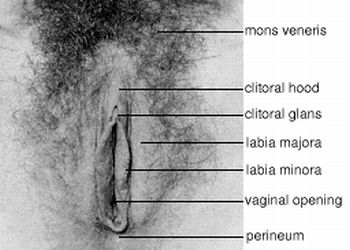Sex organ: Difference between revisions
No edit summary |
No edit summary |
||
| (6 intermediate revisions by the same user not shown) | |||
| Line 1: | Line 1: | ||
{{Header}} | {{Header}} | ||
'''[[Sex organ| - (also see page on 'Sex organs')]]''' | {{Anatomy}} | ||
<!-- '''[[Sex organ| - (also see page on 'Sex organs')]]''' | |||
:This special page is a "catch-all" cross-index page | |||
<br>{{hr}}<br> | <br>{{hr}}<br>--> | ||
A '''sex organ''', or '''primary sexual characteristic''', narrowly defined, is any of those anatomical parts of the body (which are not always bodily organs according to the strict definition) which are involved in sexual reproduction and constitute the reproductive system in a complex organism; namely: {{lookup|{{PAGENAME}}}} | A '''sex organ''', or '''primary sexual characteristic''', narrowly defined, is any of those anatomical parts of the body (which are not always bodily organs according to the strict definition) which are involved in sexual reproduction and constitute the reproductive system in a complex organism; namely: {{lookup|{{PAGENAME}}}} | ||
| Line 17: | Line 17: | ||
: The prepuce is a retractable piece of skin which covers part of the genitals of primates and other mammals - also known as foreskin | : The prepuce is a retractable piece of skin which covers part of the genitals of primates and other mammals - also known as foreskin | ||
* {{lookup|testicle}} | * {{lookup|testicle}} | ||
: the male sex gland that produces sperm and male hormones, found in some types of animals | : the male sex gland that produces sperm and male hormones, found in some types of animals | ||
* {{lookup|scrotum}} | * {{lookup|scrotum}} | ||
: The bag of skin and muscle that contains the [[testicles]] in mammals. | : The bag of skin and muscle that contains the [[testicles]] in mammals. | ||
* {{lookup|prostate}} | * {{lookup|prostate}} | ||
: A gland in male mammals surrounding the urethra just below the urinary bladder that controls the release of urine from the bladder and produces a secretion that is the fluid part of semen. | : A gland in male mammals surrounding the urethra just below the urinary bladder that controls the release of urine from the bladder and produces a secretion that is the fluid part of semen. | ||
| Line 38: | Line 38: | ||
: The external female sexual organs, collectively. | : The external female sexual organs, collectively. | ||
* {{lookup|clitoris}}), | * {{lookup|clitoris}}), | ||
: A small elongated erectile organ at the anterior part of the vulva in female mammals, homologous with the penis. (Klit in Greek means | : A small elongated erectile organ at the anterior part of the vulva in female mammals, homologous with the penis. (Klit in Greek means "key") | ||
* {{lookup|labia}} | * {{lookup|labia}} | ||
: The folds of tissue at the opening of the vulva | : The folds of tissue at the opening of the vulva, Labia majora and Labia Minora | ||
* {{lookup|vagina}} | * {{lookup|vagina}} | ||
: The passage leading from the opening of the vulva to the cervix of the uterus in female mammals. | : The passage leading from the opening of the vulva to the [[cervix]] of the uterus in female mammals. | ||
* {{lookup|cervix}} | * {{lookup|cervix}} | ||
: the lower, narrow portion of the uterus where it joins with the top end of the vagina. | : the lower, narrow portion of the uterus where it joins with the top end of the vagina. | ||
| Line 55: | Line 53: | ||
* {{lookup|Skene's gland}} | * {{lookup|Skene's gland}} | ||
: The Skene's glands (also known as the lesser vestibular, periurethral glands, or paraurethral glands) are glands located on the upper wall of the vagina, around the lower end of the urethra. They drain into the urethra and near the urethral opening. The location of the Skene's glands is also known as the Gräfenberg spot or G-spot; the general area is the urethral sponge. | : The Skene's glands (also known as the lesser vestibular, periurethral glands, or paraurethral glands) are glands located on the upper wall of the vagina, around the lower end of the urethra. They drain into the urethra and near the urethral opening. The location of the Skene's glands is also known as the Gräfenberg spot or G-spot; the general area is the urethral sponge. | ||
* {{lookup|Bartholin's gland}}s. | * {{lookup|Bartholin's gland}}s. | ||
: Two glands located slightly below and to the left and right of the opening of the vagina in women. They produce a waxy secretion which is sometimes described as being a lubrication for sexual congress. | : Two glands located slightly below and to the left and right of the opening of the vagina in women. They produce a waxy secretion which is sometimes described as being a lubrication for sexual congress. | ||
</td> | </td> | ||
| Line 61: | Line 59: | ||
</td></tr></table></center> | </td></tr></table></center> | ||
The | The Latin term '''genitalia''' (sometimes anglicized as '''genitals''') is used to describe the sex organs, and in the English language this term and '''genital area''' are most often used to describe the externally visible sex organs, known as '''primary genitalia''' or '''external genitalia''': in males the penis and scrotum, in females the vulva. | ||
The other sex organs are called the '''secondary genitalia''' or '''internal genitalia'''. An even wider notion, subjective but always prominently including the genitalia, is | The other sex organs are called the '''secondary genitalia''' or '''internal genitalia'''. An even wider notion, subjective but always prominently including the genitalia, is [[erogenous zone]]s. | ||
Gonad(s) is a sex organ that produces gamete(s), specifically the {{fn0|testis|testes}} or {{fn0|ovary|ovaries}} in humans. | |||
Organs of sexual anatomy originate from a common {{fn0|anlage}} and differentiate into male or female sex organs. The {{fn0|SRY}} {{fn0|gene}}, usually located on the {{fn0|Y chromosome}} and encoding the {{fn0|testis determining factor}}, decides the direction of this differentiation. Each sexual organ in one sex has a {{fn0|homology (biology)|homologous}} counterpart in the other one. See a {{fn0|list of homologues of the human reproductive system}}. | |||
== Anatomical terms related to sex == | == Anatomical terms related to sex == | ||
The following is a list of anatomical terms related to sex and sexuality: | The following is a list of anatomical terms related to sex and sexuality: | ||
* {{ | <div style='-moz-column-count:3; column-count:3;'> | ||
* {{ | * {{fn0|areola}} | ||
* {{ | * {{fn0|Bartholin's gland}} | ||
* {{ | * {{fn0|breast}} | ||
* {{ | * {{fn0|bulbocavernosus muscle}} | ||
* {{ | * {{fn0|bulbospongiosus muscle}} | ||
* {{ | * {{fn0|bulbourethral gland}} | ||
* {{ | * {{fn0|cervix}} | ||
* {{ | * {{fn0|Cleft of Venus}} | ||
* {{ | * {{fn0|clitoris}} | ||
* {{ | * {{fn0|common penile artery}} | ||
* {{ | * {{fn0|corona glandis}} | ||
* {{ | * {{fn0|corpora cavernosa}} | ||
* {{ | * {{fn0|corpus cavernosum}} | ||
* {{ | * {{fn0|corpus spongiosum}} | ||
* {{ | * {{fn0|Cowper's glands}} | ||
* {{ | * {{fn0|cremaster muscle}} | ||
* {{ | * {{fn0|dartos muscle}} | ||
* {{ | * {{fn0|ductus deferens}} | ||
* {{fn0|ejaculatory duct}} | |||
* {{fn0|endometrium}} | |||
* {{fn0|epididymis}} | |||
* {{fn0|Fallopian tube}} | |||
* {{fn0|foreskin}} | |||
* {{fn0|frenulum}} | |||
* {{fn0|frenulum preputii penis}} | |||
* {{fn0|frenulum labiorum pudendi}} | |||
* {{fn0|frenulum clitoridis}} | |||
* {{fn0|frenum}} | |||
* {{fn0|fundiform ligament}} | |||
* {{fn0|G-Spot}} | |||
* {{fn0|Gartner's duct}} | |||
* {{fn0|genital tubercle}} | |||
* {{fn0|genitofemoral nerve}} | |||
* {{fn0|glans}} | |||
* {{fn0|glans penis}} | |||
* {{fn0|Gräfenberg spot}} | |||
* {{fn0|hymen}} | |||
* {{fn0|internal pudendal artery}} | |||
* {{fn0|ischiocavernosus muscle}} | |||
* {{fn0|labium}} | |||
* {{fn0|labia majora}} | |||
* {{fn0|labia minora}} | |||
* {{fn0|mammae}} | |||
* {{fn0|mammary gland}} | |||
* {{fn0|meatus}} | |||
* {{fn0|mons pubis}} | |||
* {{fn0|mons veneris}} | |||
* {{fn0|Mullerian duct}} | |||
* {{fn0|nipple}} | |||
* {{fn0|ovary}} | |||
* {{fn0|ovum}} | |||
* {{fn0|oviducts}} | |||
* {{fn0|penis}} | |||
* {{fn0|perineum}} | |||
* {{fn0|prepuce}} | |||
* {{fn0|prostate}} | |||
* {{fn0|pubic hair}} | |||
* {{fn0|pubic symphysis}} | |||
* {{fn0|pubococcygeus muscle}} | |||
* {{fn0|pudendal nerve}} | |||
* {{fn0|raphe}} | |||
* {{fn0|ridged band}} | |||
* {{fn0|scrotum}} | |||
* {{fn0|seminal vesicles}} | |||
* {{fn0|semeniferous tubules}} | |||
* {{fn0|Skene's glands}} | |||
* {{fn0|sperm}} | |||
* {{fn0|spermatic cord}} | |||
* {{fn0|sphincter urethrae membranaceae}} | |||
* {{fn0|splanchnic nerves}} | |||
* {{fn0|testes}} | |||
* {{fn0|testicle}} | |||
* {{fn0|tunica albuginea (testicles)|tunica albuginea}} | |||
* {{fn0|urethra}} | |||
* {{fn0|urethral sponge}} | |||
* {{fn0|urogenital diaphragm}} | |||
* {{fn0|uterus}} | |||
* {{fn0|vas deferens}} | |||
* {{fn0|vagina}} | |||
</div> | |||
==See also== | ==See also== | ||
* {{ | <div style='-moz-column-count:3; column-count:3;'> | ||
* {{ | * {{fn0|Castration}} | ||
* {{ | * {{fn0|Circumcision}} | ||
* {{ | * {{fn0|Genital modification and mutilation}} | ||
* {{ | * {{fn0|Human sexuality}} | ||
* {{ | * {{fn0|Hysterectomy}} | ||
* {{ | * {{fn0|Intersexuality}} | ||
* {{ | * {{fn0|Intimate parts}} | ||
* {{ | * {{fn0|List of transgender-related topics}} | ||
* {{ | * {{fn0|Mastectomy}} | ||
* {{ | * {{fn0|Obstetrics and gynecology}} | ||
* {{ | * {{fn0|Oophorectomy}} | ||
* {{ | * {{fn0|Secondary sex characteristics}} | ||
* {{ | * {{fn0|Sex}} | ||
{{ | * {{fn0|Sexual behavior}}</div> | ||
{{sextechs}} | |||
{{footer}}{{macro}} | {{footer}}{{macro}} | ||
Latest revision as of 21:49, 1 June 2022
- This is an article about Human Anatomy
A sex organ, or primary sexual characteristic, narrowly defined, is any of those anatomical parts of the body (which are not always bodily organs according to the strict definition) which are involved in sexual reproduction and constitute the reproductive system in a complex organism; namely: Sex organ (Look up Sex organ in Wikipedia or Wikitionary)
Male
|
Female
|
|
The Latin term genitalia (sometimes anglicized as genitals) is used to describe the sex organs, and in the English language this term and genital area are most often used to describe the externally visible sex organs, known as primary genitalia or external genitalia: in males the penis and scrotum, in females the vulva.
The other sex organs are called the secondary genitalia or internal genitalia. An even wider notion, subjective but always prominently including the genitalia, is erogenous zones.
Gonad(s) is a sex organ that produces gamete(s), specifically the testis^ or ovary^ in humans.
Organs of sexual anatomy originate from a common anlage^ and differentiate into male or female sex organs. The SRY^ gene^, usually located on the Y chromosome^ and encoding the testis determining factor^, decides the direction of this differentiation. Each sexual organ in one sex has a homology (biology)^ counterpart in the other one. See a list of homologues of the human reproductive system^.
The following is a list of anatomical terms related to sex and sexuality:
- areola^
- Bartholin's gland^
- breast*
- bulbocavernosus muscle^
- bulbospongiosus muscle^
- bulbourethral gland^
- cervix*
- Cleft of Venus^
- clitoris*
- common penile artery^
- corona glandis^
- corpora cavernosa^
- corpus cavernosum^
- corpus spongiosum^
- Cowper's glands^
- cremaster muscle^
- dartos muscle*
- ductus deferens^
- ejaculatory duct^
- endometrium^
- epididymis^
- Fallopian tube^
- foreskin^
- frenulum*
- frenulum preputii penis^
- frenulum labiorum pudendi^
- frenulum clitoridis^
- frenum*
- fundiform ligament^
- G-Spot^
- Gartner's duct^
- genital tubercle^
- genitofemoral nerve^
- glans*
- glans penis*
- Gräfenberg spot*
- hymen^
- internal pudendal artery^
- ischiocavernosus muscle^
- labium^
- labia majora*
- labia minora*
- mammae^
- mammary gland^
- meatus*
- mons pubis^
- mons veneris^
- Mullerian duct^
- nipple*
- ovary^
- ovum^
- oviducts^
- penis*
- perineum*
- prepuce*
- prostate*
- pubic hair*
- pubic symphysis^
- pubococcygeus muscle^
- pudendal nerve^
- raphe^
- ridged band^
- scrotum*
- seminal vesicles^
- semeniferous tubules^
- Skene's glands^
- sperm*
- spermatic cord^
- sphincter urethrae membranaceae^
- splanchnic nerves^
- testes*
- testicle*
- tunica albuginea (testicles)^
- urethra*
- urethral sponge^
- urogenital diaphragm^
- uterus*
- vas deferens^
- vagina*
See also
Chat rooms • What links here • Copyright info • Contact information • Category:Root


